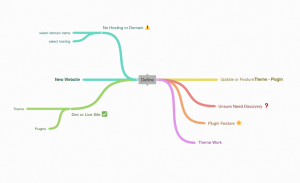Skip to content
- It can not be stressed enough how important it is to have a complete plan of process for building any new website. At the least what is required would be a Project Brief. The author of a new website would most likely start a Brief using these five elements as a starting point.
- 1. Goal identification:
- Determine what goals the new website needs to fulfill. I.e., what its purpose is.
- 2. Scope definition: Once we know the site’s goals, we can define the scope of the project. I.e., what web pages and features the site requires to fulfill the goal, and the timeline for building those out.
- 3. Sitemap and wireframe creation: With the scope well-defined, we can start digging into the sitemap, defining how the content and features we defined in scope definition will interrelate.
- 4. Content creation: Now that we have a bigger picture of the site in mind, we can start creating content for the individual pages, always keeping search engine optimization (SEO) in mind to help keep pages focused on a single topic. It’s vital that you have real content to work with for our next stage:
- 5. Visual elements: With the site architecture and some content in place, we can start working on the visual brand. Depending on the client, this may already be well-defined, but you might also be defining the visual style from the ground up. Tools like style tiles, moodboards, and element collages can help with this process.

Getting specific:
- 1. Goal identification
- Who is the site for?
- What do they expect to find or do there?
- Is this website’s primary aim to inform, to sell (ecommerce, anyone?), or to amuse?
- Does the website need to clearly convey a brand’s core message, or is it part of a wider branding strategy with its own unique focus?
- What competitor sites, if any, exist, and how should this site be inspired by/different than, those competitors?
- 2. Scope definition
- A realistic timeline for the project, including any major landmarks, can help to set boundaries and achievable deadlines. This provides an invaluable reference for both designers and clients and helps keep everyone focused on the task and goals at hand.
- 3. Sitemap and wireframe creation
- The sitemap provides the foundation for any well-designed website. It helps give web designers a clear idea of the website’s information architecture and explains the relationships between the various pages and content elements.Building a site without a sitemap is like building a house without a blueprint. And that rarely turns out well.
- 4. Content creation
- First, content engages readers and drives them to take the actions necessary to fulfill a site’s goals. This is affected by both the content itself (the writing), and how it’s presented (the typography and structural elements).
- 5. Visual elements
- Most important thing to a website is Branding. This is the visual elements on the page that a visitor records in their mind and when they visit your site, sometime latter, they remember the uniqueness of your website’s Branding and in return it gives them comfort as they feel safe being someplace they have been before.
- Branding consists of your Logo and the color schema of the website. Typically all website color schemas follow the logo. If your logo is blue and green then most of you site would have elements in similar and complimentary schemes.


Write a Reply or Comment